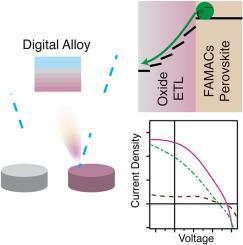当前位置:
X-MOL 学术
›
Synth. Met.
›
论文详情
Our official English website, www.x-mol.net, welcomes your
feedback! (Note: you will need to create a separate account there.)
Digital alloy contact layers for perovskite solar cells
Synthetic Metals ( IF 4.0 ) Pub Date : 2020-08-01 , DOI: 10.1016/j.synthmet.2020.116412 Olivia Sergiovanni , Ekraj Dahal , Bin Du , Benjamin Isenhart , Sean Dunfield , Joseph J. Berry , Matthew S. White
Synthetic Metals ( IF 4.0 ) Pub Date : 2020-08-01 , DOI: 10.1016/j.synthmet.2020.116412 Olivia Sergiovanni , Ekraj Dahal , Bin Du , Benjamin Isenhart , Sean Dunfield , Joseph J. Berry , Matthew S. White

|
Abstract Thin film optoelectronic devices commonly require an individual material to perform multiple functions, but the physical properties of single-composition materials often cannot be tuned to optimize these diverse requirements. The electron selective contact layer in perovskite solar cells is a prime example. The material must simultaneously have optimal conduction band alignment, facilitate carrier extraction, prevent recombination, and provide a chemically stable interface with the notoriously volatile perovskite semiconductor. The pulse-by-pulse nature of the thin-film deposition method pulsed laser deposition (PLD) provides an opportunity to form material alloys where the chemical composition is controlled at the nanometer scale. These digital alloys may prove to be a powerful materials class to meet some of the multifunctional needs of thin film devices. Using PLD to make electron transport layers from ZnO and MgZnO targets, we demonstrate that digital alloy gradients can be tuned to significantly outperform either of the parent materials in perovskite solar cells.
中文翻译:

用于钙钛矿太阳能电池的数字合金接触层
摘要 薄膜光电器件通常需要一种单独的材料来执行多种功能,但通常无法调整单一成分材料的物理特性来优化这些不同的要求。钙钛矿太阳能电池中的电子选择性接触层就是一个典型的例子。该材料必须同时具有最佳导带排列,促进载流子提取,防止复合,并提供与众所周知的易挥发钙钛矿半导体的化学稳定界面。薄膜沉积方法脉冲激光沉积 (PLD) 的逐脉冲特性提供了形成材料合金的机会,其中化学成分控制在纳米级。这些数字合金可能被证明是一种强大的材料类别,可以满足薄膜设备的一些多功能需求。使用 PLD 从 ZnO 和 MgZnO 目标制造电子传输层,我们证明可以调整数字合金梯度以显着优于钙钛矿太阳能电池中的任何一种母体材料。
更新日期:2020-08-01
中文翻译:

用于钙钛矿太阳能电池的数字合金接触层
摘要 薄膜光电器件通常需要一种单独的材料来执行多种功能,但通常无法调整单一成分材料的物理特性来优化这些不同的要求。钙钛矿太阳能电池中的电子选择性接触层就是一个典型的例子。该材料必须同时具有最佳导带排列,促进载流子提取,防止复合,并提供与众所周知的易挥发钙钛矿半导体的化学稳定界面。薄膜沉积方法脉冲激光沉积 (PLD) 的逐脉冲特性提供了形成材料合金的机会,其中化学成分控制在纳米级。这些数字合金可能被证明是一种强大的材料类别,可以满足薄膜设备的一些多功能需求。使用 PLD 从 ZnO 和 MgZnO 目标制造电子传输层,我们证明可以调整数字合金梯度以显着优于钙钛矿太阳能电池中的任何一种母体材料。











































 京公网安备 11010802027423号
京公网安备 11010802027423号